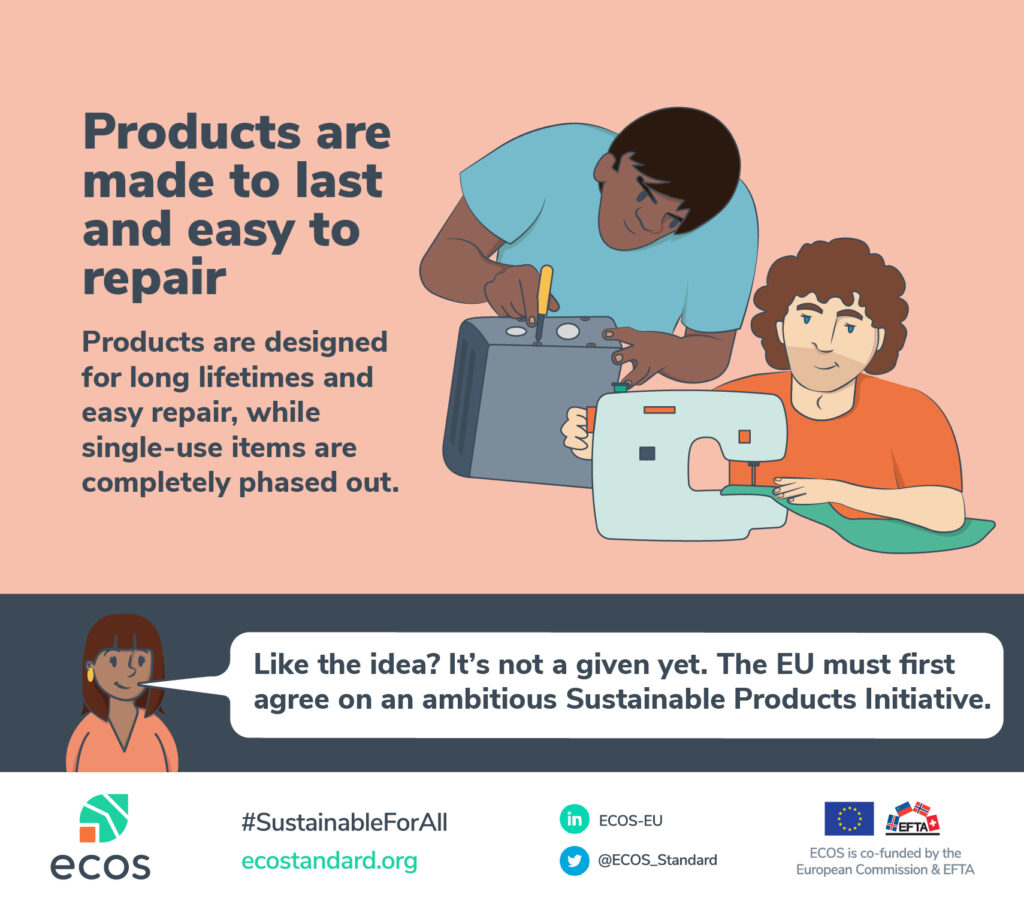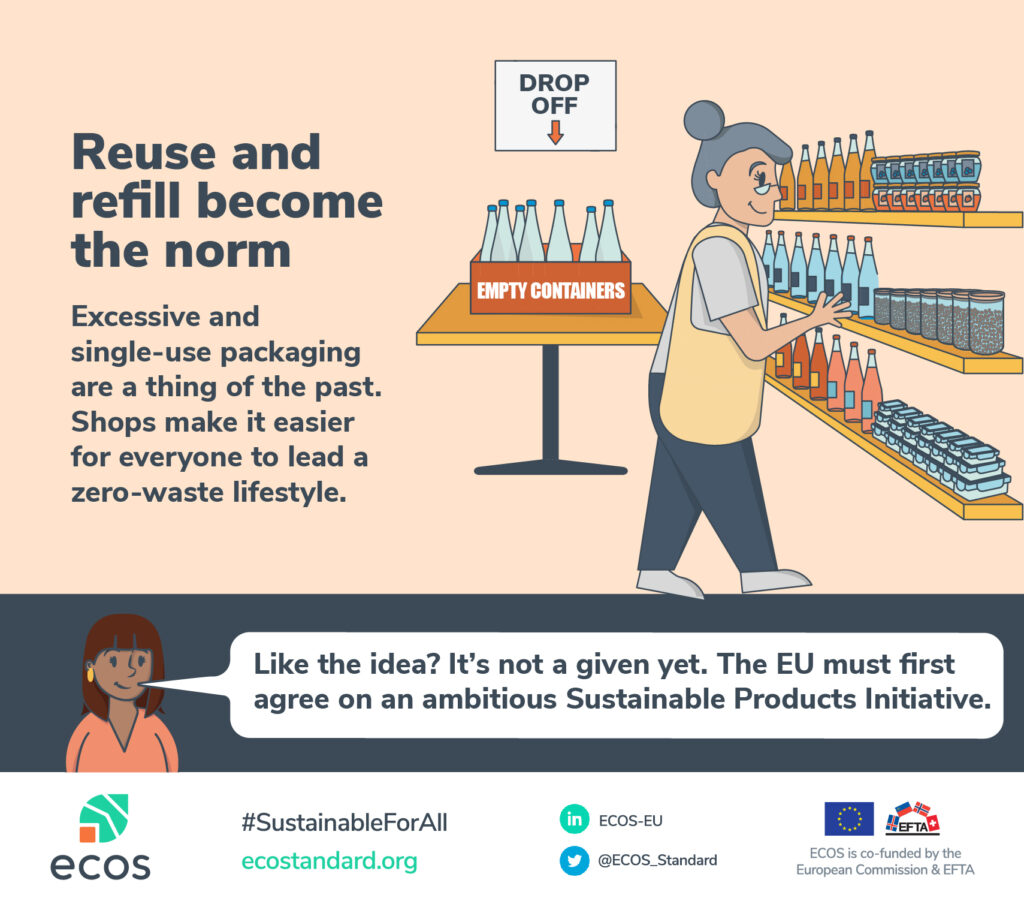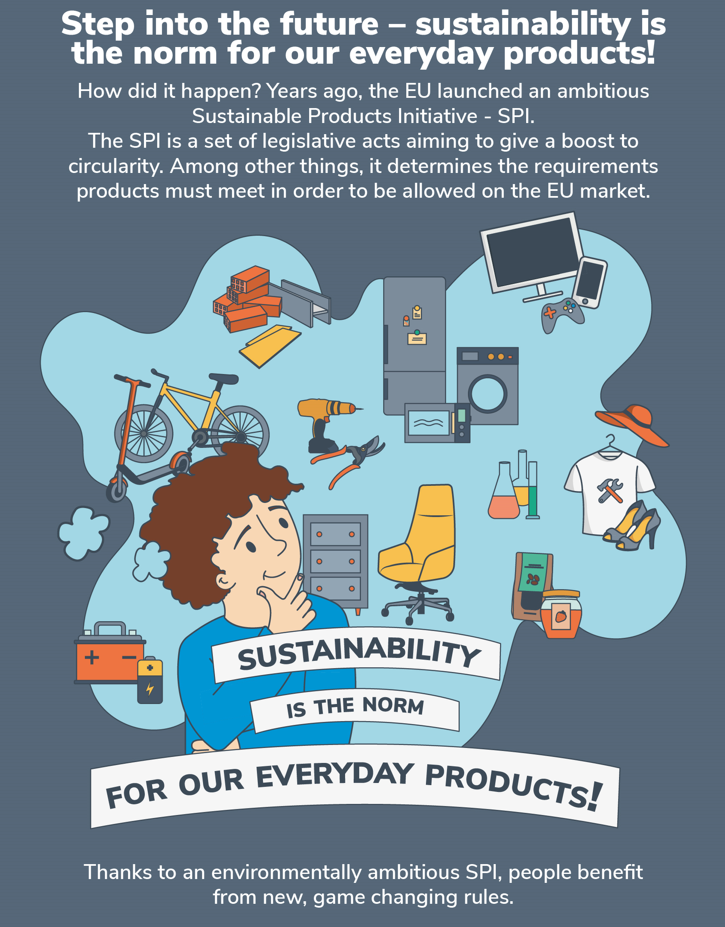‘Green’ for all? Step into a day in a future powered by an ambitious Sustainable Products Initiative
In 2022, The European Commission will launch its Sustainable Products Initiative. Through minimum requirements on circularity, digital product passports, and other new rules, this framework can potentially make sustainable products not an exception but the norm. We imagined how the SPI could change our lives through three everyday situations – what would a future of sustainable products look like?

It is a Saturday morning in 2030, and you need to run some errands: get some cleaning soap, buy a running jacket and… oh no! Just as you were leaving the house, you dropped your phone. As you go about your tasks, you can see for yourself: is sustainability the norm for everyday products in 2030?
By 2030, the Sustainable Products Initiative (SPI), which the European Commission plans to publish in 2022, will have had a significant impact on whether sustainable products are the default option when shopping. How? The SPI will seek to boost circularity by extending ecodesign policies to a broad range of products.
How much can the SPI change our daily lives? What are the main hurdles the SPI will face to become a success? Let’s step into the future.
Products are made to last and easy to repair
Oops! You were ready to leave your house, but you dropped your phone. In the past, this could have meant a hassle – but not anymore. Thanks to durable design, there is not even a scratch on it. In 2030, phones are made to last for at least ten years.
When needed, repair is easy thanks to replaceable batteries, continuous software updates, modular designs, and wide availability of spare parts at reasonable cost. In fact, your phone’s design is so simple that any handy person can fix it.
Can durable and repairable phones become a reality? ‘The most important challenge is a change in mentality. Repair needs to become a no-brainer, for all of us’, says Aline Maigret, a policy officer at Repair&Share. In her ideal scenario, companies would embrace the opportunities of circular economy, and it would be easy for citizens to choose better and more repairable options.
Political is bound to be essential, Maigret warns. She calls on regulators to consider all stakeholders when developing right-to-repair regulations, ‘including those directly impacted by measures put forward, such as repairers’. With ambitious requirements and a comprehensive policy framework, the SPI could make all electronics sustainable.

Reuse and refill, made simple
You ran out of floor soap. In the past, cleaning products used to come in individual plastic packaging but not anymore. It is 2030: excessive and single-use packaging is a thing of the past! At the supermarket, you find most daily products in reusable containers that you can refill. Standardised design makes it easy to use the same container for different products or quantity levels, and all shops use the same containers, so you can use the ones provided or bring them from home.
‘[In an ideal future], there are plenty of collection points to choose from, and shops use the same types of containers. No headache!’, says Justine Maillot, policy coordinator of the Rethink Plastic alliance.
Unfortunately, this future is far from certain. ‘Sustainable products can only become the norm if the appropriate production, delivery and consumption systems are put in place’, Maillot warns. Even if reusable products and packaging are becoming increasingly available, in 2021, they still operate in a system mainly designed for single-use, which puts reusables at a disadvantage against wasteful operators, she explains.
How can the SPI change this? By setting circular design criteria to support reuse and refill products and systems, including across borders through harmonisation. The European Union can ensure the most wasteful products are just not allowed on the market. Only the best, most sustainable choices should be available.

Environmental information is available, reliable and relevant
You have recently started running – great! But now you are missing a jacket for the colder days. This makes you worry: sports equipment usually contains many synthetic materials, which contribute to plastic pollution. But you needn’t fret: in 2030, only products that meet a set of demanding sustainability criteria are allowed on the market.
Not only that, it is easy to find the most sustainable options in any shop. A ‘product passport’ gives you all the information on aspects such as recycled content, instructions for repair and mending or details on inks, adhesives and other chemical substances contained in the garment you are planning to buy. This information is based on strict requirements and assessments – you can be sure that what you read on the label is accurate.
In the case of your jacket, you can see that it contains 85% of recycled fibres, the workers who made it were well paid, and detailed care instructions will help you make your garment last longer. If you want to know more, a QR code leads you to more details.
Comprehensive product labels might seem like a straightforward ask, but in 2021 the existing greenwashing practices often make it hard for people to buy sustainably. A recent ECOS report found claims on clothing labels as outlandish as ‘biodegradable jackets’; the Changing Market’s Synthetics Anonymous report found that 59% of claims on clothing items are misleading or false. ‘[Greenwashing] is used to derail and delay ambitious legislation (…), so that business as usual can continue for as long as possible’, says Nuša Urbancic, campaigns manager for the Changing Markets Foundation.

How can sustainable products truly become the norm?
The SPI has the potential to introduce game-changing rules and progressively exclude the most unsustainable products from the EU market. It should tackle the ever-increasing amount of short-lived, single-use items and mainstream long-lasting, toxic-free and easy-to-repair products, while providing reliable information to make informed and truly sustainable choices about our everyday products.
As you run your Saturday morning errands in 2030, caring for the environment should not be complicated. A pipe dream? It can (and should!) become a reality if the European Union launches an environmentally ambitious SPI. The sooner, the better.
What could our everyday lives look like if sustainable products became the norm? Find out below! Click on the image to see it in greater detail.



